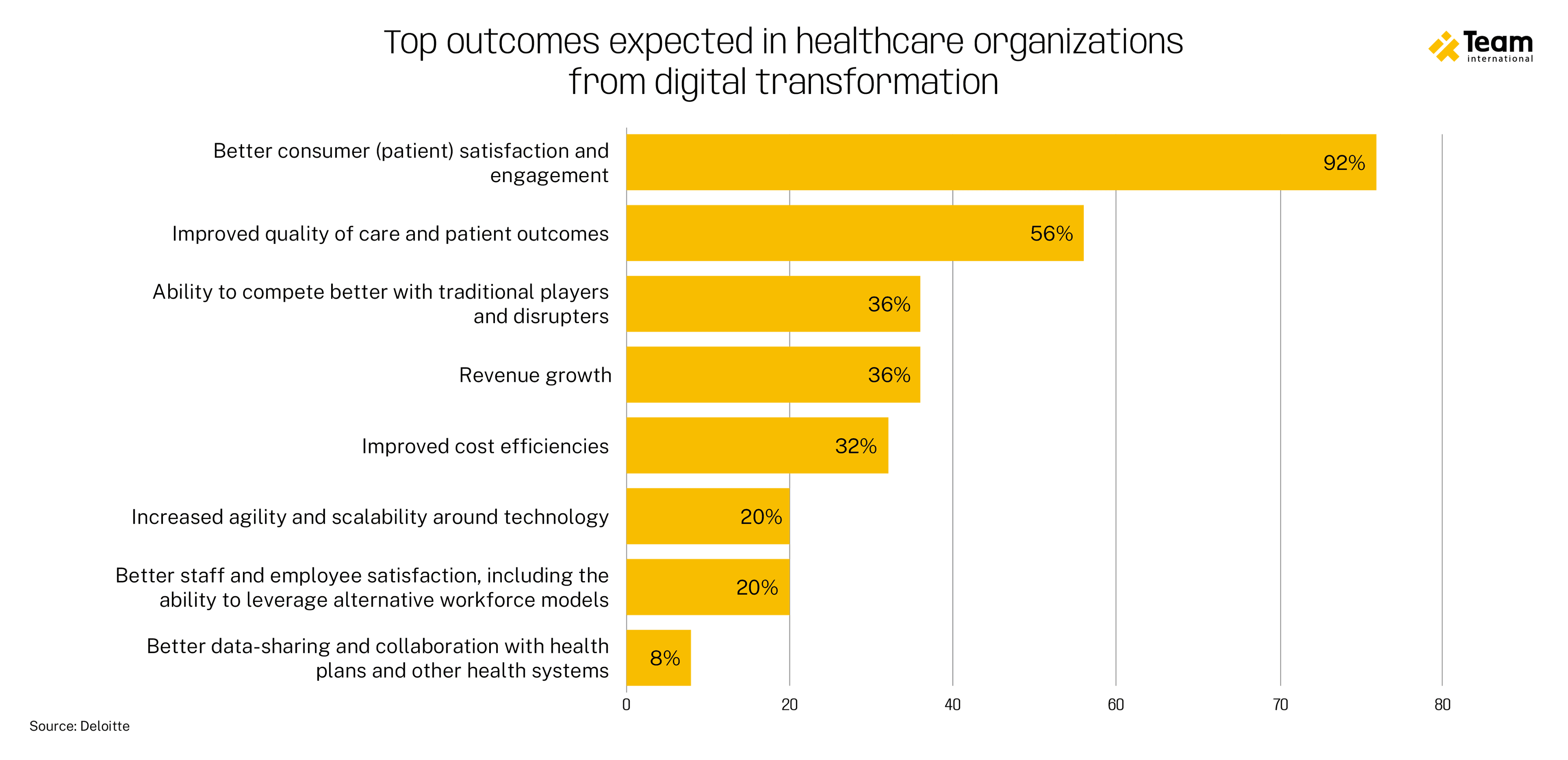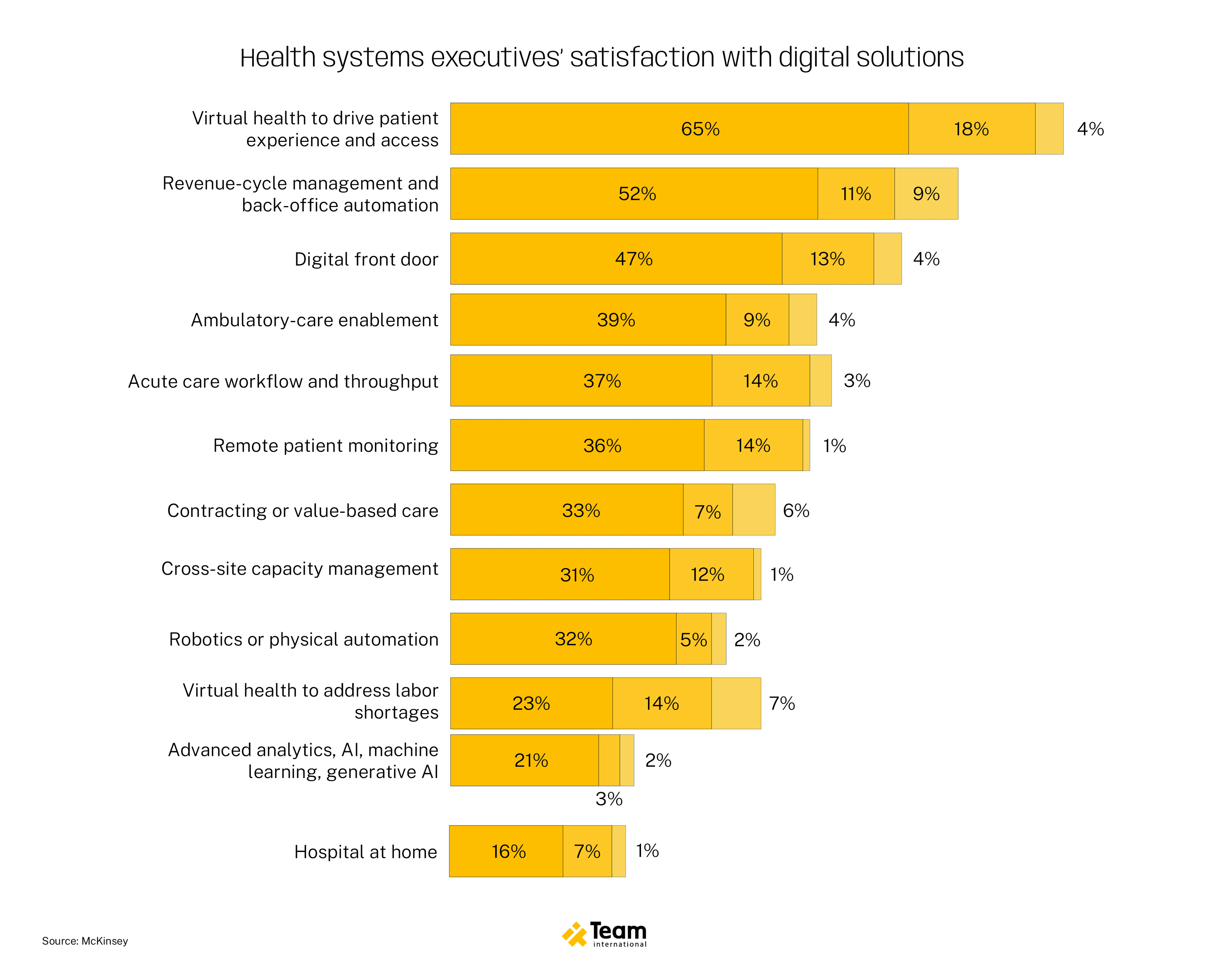Healthcare is constantly pressured to deliver better outcomes while reducing costs and meeting strict regulatory demands. Yet, many organizations still rely on fragmented systems and manual workflows that slow diagnoses, increase administrative burdens, and compromise the patient experience.
Tailored digital transformation changes this reality. Organizations like yours can reimagine how care is delivered by designing healthcare IT solutions specifically for the medical sector—integrating data, automating critical processes, and supporting clinicians in real time. The financial impact is equally compelling: experts project AI, traditional machine learning, and deep learning to generate net savings of up to $360 billion in healthcare spending, proving that digital transformation in healthcare is not just operationally smart but economically transformative.
Let’s explore how tech advancements innovate and reshape healthcare processes and patient care, paving the way for a more efficient, accessible, and user-centered future.
Why healthcare requires tailored digital transformation
Healthcare is unlike any other industry. Patient data must remain private and secure under stringent regulations like HIPAA, GDPR, and local data-protection laws. Workflows must also adapt to diverse care settings—from hospitals and clinics to home-based care—while ensuring life-critical continuity.
Generic, off-the-shelf digital solutions often fail. They may digitize existing workflows, but rarely solve deeper issues such as interoperability in healthcare IT, fragmented electronic health records system data, or inefficient resource allocation. A tailored digital transformation strategy, on the other hand, starts with each organization's unique operational and clinical realities.
By combining advanced analytics, secure cloud architectures, and domain-specific design, customized IT solutions enable healthcare providers to reengineer processes rather than move them online. This approach simultaneously enhances patient safety and staff efficiency while supporting long-term scalability and innovation.

Key IT solutions powering change
Once the need for a tailored approach is clear, the next question is how to make it happen. Below are some of the most impactful IT solutions that reshape healthcare processes and elevate patient care:
1. Data integration and interoperability
Healthcare data lives in many silos—electronic health records systems, diagnostic imaging, labs, pharmacy systems, and more. Custom-built data integration layers and interoperability frameworks bring these sources together, creating real-time, 360° patient views. This unified perspective supports faster diagnoses, reduces errors, and strengthens care coordination.
2. AI and predictive analytics
Machine learning and artificial intelligence algorithms detect patterns in massive datasets to forecast patient risks, predict resource needs, and guide treatment decisions. Through predictive analytics in patient care and AI automation in healthcare, hospitals can reduce readmissions, optimize staffing, and intervene earlier for better outcomes.
3. IoT and remote monitoring
Connected devices—from wearable health technology to hospital equipment—enable continuous monitoring of vital metrics and other health indicators. Combined with edge computing, these systems trigger instant alerts and provide long-term insights, allowing clinicians to act before issues escalate.
4. Secure cloud infrastructure
Tailored strategies for cloud computing in healthcare offer flexibility to scale critical applications while maintaining strict healthcare IT compliance and introducing robust cybersecurity solutions. Hybrid and multi-cloud models ensure that sensitive data is both protected and always available, even during high-demand periods.
Impact on patient care and operations
The true value of tailored digital transformation emerges in measurable outcomes—for both patients and healthcare providers. By integrating advanced IT solutions into everyday workflows, organizations unlock improvements beyond efficiency. According to McKinsey, most health system executives now rank digital and AI transformation as a high or top priority, and those who have already invested report broad satisfaction across all investment areas.
Some clear areas where IT solutions have become game-changers are:
Faster diagnostics and treatment: Unified data and AI-driven insights dramatically reduce the time from testing to treatment, enabling clinicians to make more informed decisions sooner and improve health outcomes.
Personalized care plans: Predictive analytics and patient-specific data support individualized treatment pathways, increasing adherence and satisfaction while reducing the likelihood of complications.
Operational efficiency: Automated scheduling, billing, and inventory management frees medical staff from repetitive administrative tasks, allowing them to spend more time with patients.
Cost control and sustainability: By predicting maintenance needs and optimizing resource allocation, healthcare facilities lower operational costs and minimize waste, which is critical for long-term sustainability.

How can your company innovate in the healthcare sector? Having built over a dozen custom software solutions for industry leaders, at TEAM, we understand the challenges healthcare organizations face when trying to modernize, from non-negotiable regulatory compliance and data privacy requirements to the need for seamless interoperability across complex systems. Drawing on years of experience in this sector, we’ve seen what works—and what often slows progress.
So, here’s how you should move forward:
Start with a clear digital strategy: Define measurable and realistic goals (SMART), engage clinical and operational leaders early, and focus on quick wins that build momentum.
Prioritize interoperability and data quality: Ensure that every solution—from AI diagnostics to IoT monitoring—integrates smoothly with your legacy systems and delivers actionable insights.
Build a corporate culture of continuous innovation: Encourage cross-functional collaboration, invest in staff training, and stay flexible so your digital ecosystem can adapt over time.
A great example is the Texas Center for Lifestyle Medicine, where maintaining accurate data in its electronic health records system was critical. Manually auditing medical records and validating ICD-10 and CPT codes was laborious and error-prone, leading to over 2,000 claim denials per month. After TEAM assisted the organization in implementing RPA in healthcare that audits daily progress notes and flags mismatches, the Center achieved an 80 percent reduction in claim denials, with over $1 million saved annually and more than 1700 percent ROI in the first year.
You don’t have to go through this journey alone—finding a trusted tech partner who can help bring your ideas and goals to life is always a wise choice.
Next steps
Digital healthcare transformation is not just about adopting new tools—it’s about rethinking how care is delivered and how operations can support that mission. With the right strategy, technology becomes a powerful enabler of safer, more efficient, patient-centered healthcare.
Now is the time to start. Define your vision, engage your teams, and choose the right partner to turn plans into reality. Whether you are streamlining operations with patient management software, enhancing user care through digital patient access, or exploring managed IT services for healthcare, the journey is easier and more impactful when you don’t walk it alone.
